By providing your information, you agree to our Terms of Use and our Privacy Policy. We use vendors that may also process your information to help provide our services. This site is protected by reCAPTCHA Enterprise and the Google Privacy Policy and Terms of Service apply.
Best to Worst: Every Steven Spielberg TV Project Ranked

18) “Falling Skies” (2011-2014)
 This TNT drama received early praise for being a better-than-average summer TV show (and, more likely, for employing a likable lead in Noah Wyle and sporting Spielberg’s name on much of its marketing materials). Looking back, it’s neither above-average television — at best, it’s C-grade sci-fi — nor is it better than many shows dominating the summer months today. “Falling Skies” failed to create compelling characters even using the easy “rah rah” template of a humans vs. aliens global showdown, and it had serious lapses in basic logic unrelated to its genre’s forgiving nature regarding common sense. I’ll never forget watching the surviving humans march in a large group during broad daylight while trying to hide from their alien oppressors — advanced beings who are supposedly excellent at tracking their prey, yet can’t spot them in a pack of hundreds moving slowly through their line of sight.
This TNT drama received early praise for being a better-than-average summer TV show (and, more likely, for employing a likable lead in Noah Wyle and sporting Spielberg’s name on much of its marketing materials). Looking back, it’s neither above-average television — at best, it’s C-grade sci-fi — nor is it better than many shows dominating the summer months today. “Falling Skies” failed to create compelling characters even using the easy “rah rah” template of a humans vs. aliens global showdown, and it had serious lapses in basic logic unrelated to its genre’s forgiving nature regarding common sense. I’ll never forget watching the surviving humans march in a large group during broad daylight while trying to hide from their alien oppressors — advanced beings who are supposedly excellent at tracking their prey, yet can’t spot them in a pack of hundreds moving slowly through their line of sight.
Spielberg has always been interested in science fiction and what’s coming in our world’s soon-to-be immediate future. Sometimes, his fascination with the subject works to his advantage, as it did with “Close Encounters of the Third Kind” and “Minority Report.” At other times, the Oscar-winner stretches his good name thin by producing some stinkers without his close vision to drive the stories home. “Falling Skies” is one of those duds, lacking the basic elements that make good sci fi great.
17) “Under the Dome” (2013-2014)
For the purposes of this list, we will give this CBS drama, about what happens when a small town stops being polite and starts being real(ly trapped inside a big mysterious dome), the same serious consideration that it gives to good plotting and common sense.
Here is the best thing to come from “Under the Dome”:

We’ll assume, for Steven Spielberg‘s benefit, that he had something to do with it. But one awesome cow death isn’t enough to get this show any higher on the list.
16) “Into the West” (2005)
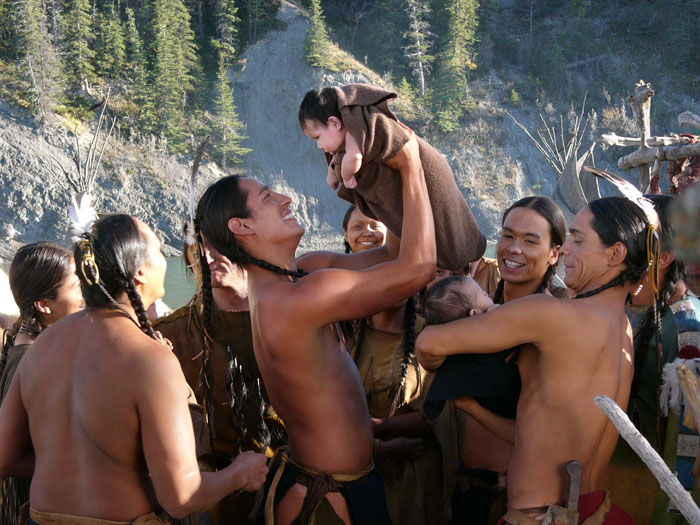 Perhaps Spielberg and TNT just don’t mix (or perhaps we here at Indiewire just don’t think they do). This miniseries following the lives of a Native American and an early white settler earned a ton of Emmy nominations, but notably didn’t win any of the major awards (it wasn’t a strong year for the category, either). Anyone who watched it would understand why. The series was a paint-by-numbers made-for-TV special with below-average performances — Josh Brolin appeared, but did not impress — and a through-line as predictable as any other “cowboys and indians” tale.
Perhaps Spielberg and TNT just don’t mix (or perhaps we here at Indiewire just don’t think they do). This miniseries following the lives of a Native American and an early white settler earned a ton of Emmy nominations, but notably didn’t win any of the major awards (it wasn’t a strong year for the category, either). Anyone who watched it would understand why. The series was a paint-by-numbers made-for-TV special with below-average performances — Josh Brolin appeared, but did not impress — and a through-line as predictable as any other “cowboys and indians” tale.
Spielberg’s influence wasn’t greatly felt. If his traditional themes shown through anywhere, it was on the importance both leading men placed in their families. Each had a mixed history with their parents, making their characters rebellious scamps continuously searching for new heroes to worship. It wasn’t enough to sustain a dull six-hour TV show, making it one of Spielberg’s more forgettable missteps.
15) “The River” (2012)
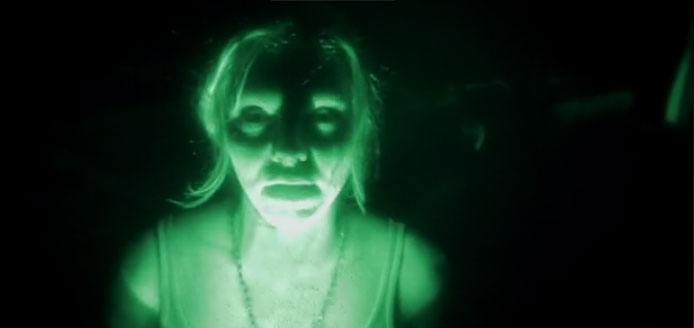 ABC’s short-lived horror series (yes, the family-friendly network once tried its hand at “X-Files”-esque programming) is definitely closer to executive producer and creator Oren Peli’s territory than Spielberg’s. The director of “Paranormal Activity” tried his hand at TV without straying far from what made him famous — found-footage frights. “The River” tracked a family’s quest to find their lost father, a famous explorer with his own long-running TV show who went missing and was feared dead after six months of searching. Then his distress beacon sounds and a reluctant son, determined wife, and heartless TV crew jump back into the Amazon jungle in hopes of finding him (and a story for the network).
ABC’s short-lived horror series (yes, the family-friendly network once tried its hand at “X-Files”-esque programming) is definitely closer to executive producer and creator Oren Peli’s territory than Spielberg’s. The director of “Paranormal Activity” tried his hand at TV without straying far from what made him famous — found-footage frights. “The River” tracked a family’s quest to find their lost father, a famous explorer with his own long-running TV show who went missing and was feared dead after six months of searching. Then his distress beacon sounds and a reluctant son, determined wife, and heartless TV crew jump back into the Amazon jungle in hopes of finding him (and a story for the network).
Instead, they discover a magical tribe, giant blue fireflies with hidden powers, and a black ghost akin to a faster, more murderous Smoke Monster from “Lost.” Parts of the eight-episode series work just fine, but the simple premise is squandered on C-grade actors and exposition-heavy scripts. Peli’s grainy hand held video doesn’t blend well with the non-diegetic shots most likely insisted on by the network, either, making “The River” a mess on multiple fronts. Don’t waste your time searching for answers.
14) “SeaQuest DSV/2023” (1993-1995)

13) “Smash” (2012-2013)

12) “Extant”

11) “Terra Nova” (2011)
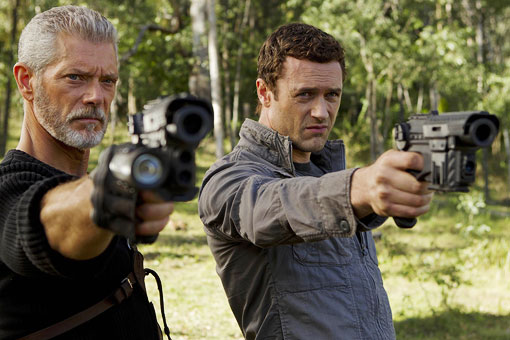
10) “Fievel’s American Tails” (1992)

9) “United States of Tara” (2009-2011)
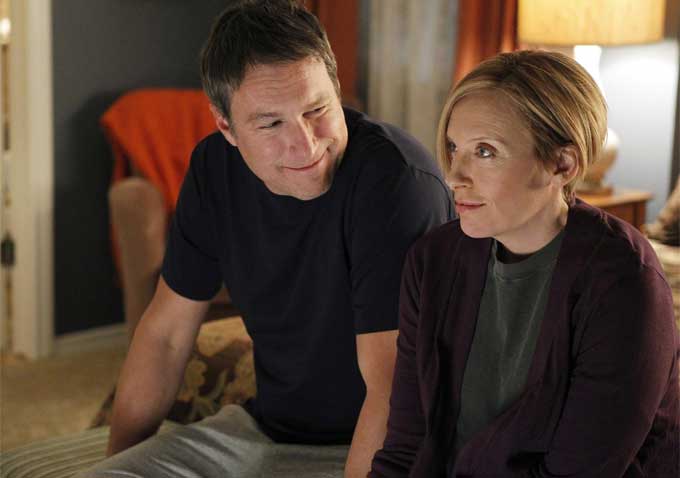 In “United States of Tara,” Toni Collette is the titular Tara, a woman who suffers from a cartoonish version of dissociative identity disorder. Collette conquers the challenge of embodying multiple personalities, playing everything from a simpering housewife to a psychotic maniac; she even gets in drag to play a blue collar man’s man. Soapy and fun as the show may be, many plot lines feel like retreads when the whole show is built on one gimmick, and writer Diablo Cody’s cloyingly precious schtick doesn’t help. A standout comes via up-and-comer Brie Larson in an early, breakout performance.
In “United States of Tara,” Toni Collette is the titular Tara, a woman who suffers from a cartoonish version of dissociative identity disorder. Collette conquers the challenge of embodying multiple personalities, playing everything from a simpering housewife to a psychotic maniac; she even gets in drag to play a blue collar man’s man. Soapy and fun as the show may be, many plot lines feel like retreads when the whole show is built on one gimmick, and writer Diablo Cody’s cloyingly precious schtick doesn’t help. A standout comes via up-and-comer Brie Larson in an early, breakout performance.
8) “Freakazoid” (1995-1997)
 Created by Bruce Timm and Paul Dini, “Freakazoid!” centers on 16-year-old computer geek Dexter Douglas, who, after being infected with a computer bug, gains superhuman capabilities — don’t ask how it’s possible, just go with it — subsequently resulting in the development of his superhero alter-ego, the unhinged, ghostly-looking Freakazoid. Dexter, though, is just like you and me: painfully ordinary. Although he uses his “extraordinary” abilities for good, his simultaneous, shameless misuse of said abilities for petty personal gain — i.e. get a kiss from a girl, exact verbal revenge upon someone who bullied his everyday identity — makes it difficult to admire him as a hero at the end of the day.
Created by Bruce Timm and Paul Dini, “Freakazoid!” centers on 16-year-old computer geek Dexter Douglas, who, after being infected with a computer bug, gains superhuman capabilities — don’t ask how it’s possible, just go with it — subsequently resulting in the development of his superhero alter-ego, the unhinged, ghostly-looking Freakazoid. Dexter, though, is just like you and me: painfully ordinary. Although he uses his “extraordinary” abilities for good, his simultaneous, shameless misuse of said abilities for petty personal gain — i.e. get a kiss from a girl, exact verbal revenge upon someone who bullied his everyday identity — makes it difficult to admire him as a hero at the end of the day.
7) “Taken” (2002)

6) “Tiny Toon Adventures” (1990-1992)
 Before “Animaniacs” and “Pinky and the Brain,” Warner Bros. Animation’s first collaboration with Spielberg came in the form of a zany return to the Loony Tunes universe. “Tiny Toon Adventures” followed the newest generation of Loony Tunes as they attended Acme Looniversity, a school for young cartoons to learn how to be funny. Faculty members included Bugs, Daffy, Porky, and other beloved members of the gang.
Before “Animaniacs” and “Pinky and the Brain,” Warner Bros. Animation’s first collaboration with Spielberg came in the form of a zany return to the Loony Tunes universe. “Tiny Toon Adventures” followed the newest generation of Loony Tunes as they attended Acme Looniversity, a school for young cartoons to learn how to be funny. Faculty members included Bugs, Daffy, Porky, and other beloved members of the gang.
“Tiny Toon Adentures” was the beginning of a renaissance for Warner Bros. Animation, and Spielberg was largely to thank for that. As executive producer, he planned to return the studio to its former glory by creating a new generation of characters for children to love.
Spielberg said of the show, “We’ve created what some people might consider the offspring of the Loony Tunes characters, or maybe just their distant cousins.” How the Loony Tunes were able to procreate when the closest they had to a female character was Bugs in drag remains a mystery, but biological discrepancies aside, “Tiny Toons” will be remembered for it’s wacky, self-aware humor and for opening the door for a new era of cartoons.
5) “Amazing Stories” (1985-1987)
 Long before it was trendy or even acceptable for movie stars to dip their toes into TV, Spielberg got a whole gang of them to do just that for his NBC program, “Amazing Stories.” The short-lived and low-rated anthology series blended elements of drama, comedy, and science fiction, much like its creator and occasional director did in his feature films. Though fans were turned off by some of the more fantastical elements of the short stories — episodes were usually 30 minutes, though a couple were extended to nearly 50 — the series was a creative juggernaut and a sign of things to come for the medium (while still owing much of its structuring to “The Twilight Zone”).
Long before it was trendy or even acceptable for movie stars to dip their toes into TV, Spielberg got a whole gang of them to do just that for his NBC program, “Amazing Stories.” The short-lived and low-rated anthology series blended elements of drama, comedy, and science fiction, much like its creator and occasional director did in his feature films. Though fans were turned off by some of the more fantastical elements of the short stories — episodes were usually 30 minutes, though a couple were extended to nearly 50 — the series was a creative juggernaut and a sign of things to come for the medium (while still owing much of its structuring to “The Twilight Zone”).
Spielberg enlisted an impressive group of actors for the series, including Kevin Costner, Sid Caeser, Harvey Keitel, Jon Lithgow, Charlie Sheen, Patrick Swayze, Danny DeVito and Kyra Sedgwick. He helmed a few episodes himself, but also brought on other filmmakers to help out (Robert Zemeckis directed an episode with “Back to the Future” star Christopher Lloyd). They lent a cinematic vision to the 4:3 fare being broadcast on old tube TVs, with Spielberg notably paying homage to “Train Pulling Into a Station” in the series’ first episode. He also used plenty of long shots and impressive (at the time) CGI to try to make the at-home experience as close as you could get to a real movie theater. He was ahead of his time, and later found the perfect outlet and era for his best shows.
4) The Pacific (2010)
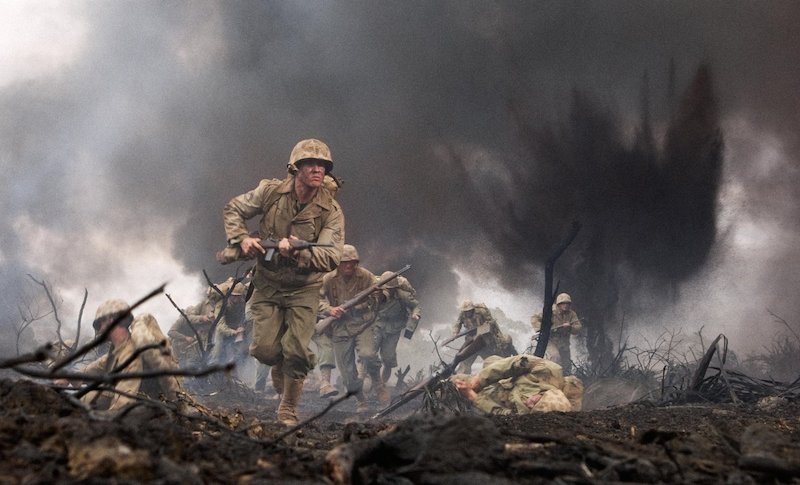 When Spielberg and Hanks returned to the second world war after successfully chronicling it twice already, many thought it might be overkill. Indeed, “The Pacific” didn’t leave the same mark on the medium as “Saving Private Ryan” and “Band of Brothers,” but it certainly paved its own path to success. Tackling the less-worn dramatic territory of the War in the Pacific, the 2010 miniseries kept a similar tone to its predecessor while injecting some fresh life to the franchise, namely in its expensive (and expansive) CGI.
When Spielberg and Hanks returned to the second world war after successfully chronicling it twice already, many thought it might be overkill. Indeed, “The Pacific” didn’t leave the same mark on the medium as “Saving Private Ryan” and “Band of Brothers,” but it certainly paved its own path to success. Tackling the less-worn dramatic territory of the War in the Pacific, the 2010 miniseries kept a similar tone to its predecessor while injecting some fresh life to the franchise, namely in its expensive (and expansive) CGI.
Spielberg’s influence was felt to a lesser degree on this than “Band of Brothers.” Many of the action sequences on land were shot in a similarly gritty fashion to what the Oscar winner established in his earlier works, but the aerial and ocean scenes broke up the darkness with the heat these soldiers fought every day. “The Pacific” is both lighter and darker than Spielberg’s past work. The visuals embrace the story’s landscape while the characters themselves weren’t quite as warm as their environment. No one stood out to the level of Winters (Damian Lewis), Nixon (Ron Livingston), or Buck (Neal McDonough) in part because their war in the sea was so different than Easy Company’s on land. Kudos goes to Spielberg, Hanks, and the multiple writers and directors for finding that unique story when they easily could have repeated an old one.
3) Pinky and the Brain (1995-1998)
 The characters Pinky and the Brain first appeared in 1993, as a regular segment in “Animaniacs,” later on gaining their own spin-off that lasted four seasons. “Pinky and the Brain” was the fourth collaboration between Warner Bros. Animation and Spielberg and a highly successful one at that — the series won the Emmy for Outstanding Animated Program in 1996 for the episode “A Pinky and the Brain Christmas.”
The characters Pinky and the Brain first appeared in 1993, as a regular segment in “Animaniacs,” later on gaining their own spin-off that lasted four seasons. “Pinky and the Brain” was the fourth collaboration between Warner Bros. Animation and Spielberg and a highly successful one at that — the series won the Emmy for Outstanding Animated Program in 1996 for the episode “A Pinky and the Brain Christmas.”
The animated tale follows the adventures of two scientifically modified lab mice and their episodic, haphazard attempts to “take over the world” or rather, the Brain’s (as portrayed by Maurice LaMarche imitating Orson Welles) attempts to take over the world — as he always declared in the undeniably catchy theme of the show. Pinky (voiced by Rob Paulsen, with a cockney English accent) plays as the Brain’s dimwitted friend best known for his made up, interjectional words such as “narf” and “zoit.”
The contrasting personalities of the two characters worked as a constant source of comedy. Similar to the “Animaniacs,” the show often played with subversive adult humor, pop culture references and parodies, including caricatures of celebrities ranging from David Letterman to the Clintons. A rehash of the series titled, “Pinky, Elmyra and the Brain” lasted for 13 episodes before ending in 1999. Notably, it was Spielberg’s last project with Warner Bros. Animation.
2) Animaniacs (1993-1998)

The Warner trio was the kid-friendly bridge that glued the animated variety show together, but its individual segments were what kept older viewers hilariously addicted. Be it Slappy Squirrel’s meta spin on Looney Tunes and the media industry (animated versions of Siskel & Ebert called Eggbert & Hisskill remain a standout), Rita and Runt’s homage to “Of Mice and Men” and “Rain Man” or The Goodfeathers’ channeling of the Italian American gangsters in Francis Ford Coppola’s classic, “Animaniacs” deftly balanced kid-friendly shenanigans with a dynamite Hollywood satire in each and every episode. For this reason alone, “Animaniacs” ranks as one of the best cartoon comedies ever made, but given the countless other memorable gags, from Dot’s Mel Gibson obsession to the PG-13 sexiness of Hello Nurse, the rapid-fire spirit of this Spielberg-produced classic is truly too much of a good thing.
1) Band of Brothers (2001)
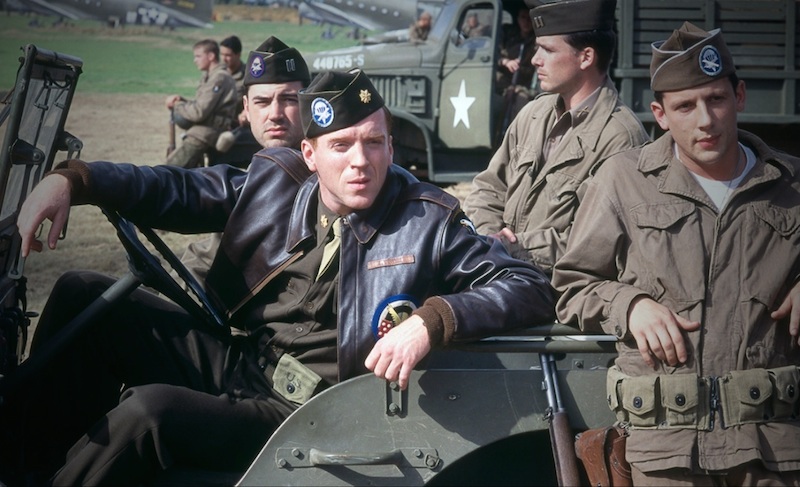 Just three years after “Saving Private Ryan” won Steven Spielberg his second Best Director Oscar (and was unjustly denied a Best Picture trophy to go with it), the most popular duo behind the iconic war film released another WWII project with a very similar look. At the time, a made-for-TV follow-up may have sounded like a terrible idea. How could a miniseries, even from Tom Hanks and Spielberg, live up to the visceral spectacle of its predecessor? Not only did it match the high levels of authenticity, intensity, and sincerity established by “Saving Private Ryan” — it surpassed them.
Just three years after “Saving Private Ryan” won Steven Spielberg his second Best Director Oscar (and was unjustly denied a Best Picture trophy to go with it), the most popular duo behind the iconic war film released another WWII project with a very similar look. At the time, a made-for-TV follow-up may have sounded like a terrible idea. How could a miniseries, even from Tom Hanks and Spielberg, live up to the visceral spectacle of its predecessor? Not only did it match the high levels of authenticity, intensity, and sincerity established by “Saving Private Ryan” — it surpassed them.
“Band of Brothers” is a towering achievement in television. It — along with “From the Earth to the Moon” — helped establish the miniseries as a respected and coveted television staple, paving the way for future successes “Angels in America,” “John Adams,” “Mildred Pierce,” and, of course, “The Pacific.” Who told the story of Easy Company also helped bridge the gap between film and television, showing that even the most prominent film directors could find a place to play in TV. Finally, the story itself is wholly compelling and lends itself to endless repeat viewings thanks in large part to the tone Spielberg established in “Saving Private Ryan.” He may not have gotten behind the camera himself, but his impression is still felt throughout the 10-part opus.
[Editor’s Note: Only series lasting more than one episode and having Spielberg’s involvement throughout were included here. Ben Travers, Liz Shannon Miller, Shipra Gupta, Zach Sharf, Jake Folsom, Michele Debczak and Zainab Akonde contributed to this article.]
By providing your information, you agree to our Terms of Use and our Privacy Policy. We use vendors that may also process your information to help provide our services. This site is protected by reCAPTCHA Enterprise and the Google Privacy Policy and Terms of Service apply.

















